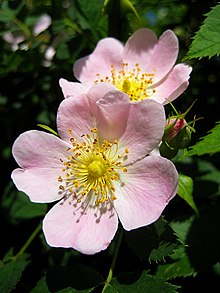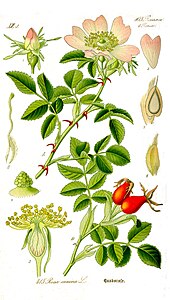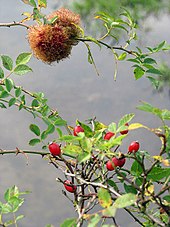
A rose is either a woody perennial flowering plant of the genus Rosa, in the family Rosaceae, or the flower it bears. There are over three hundred species and tens of thousands of cultivars.They form a group of plants that can be erect shrubs, climbing, or trailing, with stems that are often armed with sharp prickles. Their flowers vary in size and shape and are usually large and showy, in colours ranging from white through yellows and reds. Most species are native to Asia, with smaller numbers native to Europe, North America, and northwestern Africa. Species, cultivars and hybrids are all widely grown for their beauty and often are fragrant. Roses have acquired cultural significance in many societies. Rose plants range in size from compact, miniature roses, to climbers that can reach seven meters in height. Different species hybridize easily, and this has been used in the development of the wide range of garden roses.

The rose hip or rosehip, also called rose haw and rose hep, is the accessory fruit of the various species of rose plant. It is typically red to orange, but ranges from dark purple to black in some species. Rose hips begin to form after pollination of flowers in spring or early summer, and ripen in late summer through autumn.

Rosa dumalis, the glaucous dog rose, is a species of rose in the Rosaceae family. The native range of this rose stretches from Europe to the Caucasus and also down to northwestern Africa.

Rosa rugosa is a species of rose native to eastern Asia, in northeastern China, Japan, Korea and southeastern Siberia, where it grows on beach coasts, often on sand dunes. It should not be confused with Rosa multiflora, which is also known as "Japanese rose". The Latin word "rugosa" means "wrinkled", referring to the wrinkled leaves. Often used as an ornamental plant, it has become invasive in parts of Europe, North America and South America.

Rosa multiflora is a species of rose known commonly as multiflora rose, baby rose, Japanese rose, many-flowered rose, seven-sisters rose, Eijitsu rose and rambler rose. It is native to eastern Asia, in China, Japan, and Korea. It should not be confused with Rosa rugosa, which is also known as "Japanese rose", or with polyantha roses which are garden cultivars derived from hybrids of R. multiflora. It was introduced to North America, where it is regarded as an invasive species.

Chamaenerion angustifolium is a perennial herbaceous flowering plant in the willowherb family Onagraceae. It is known in North America as fireweed and in the British Isles as rosebay willowherb. It is also known by the synonyms Chamerion angustifolium and Epilobium angustifolium. It is native throughout the temperate Northern Hemisphere, including large parts of the boreal forests.
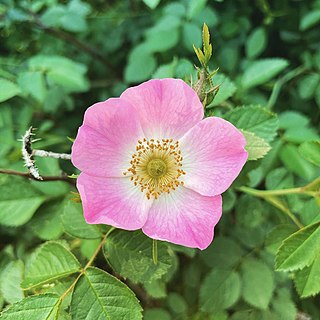
Rosa rubiginosa is a species of rose native to Europe and western Asia.
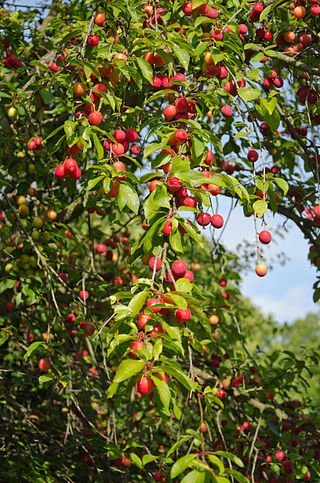
Prunus cerasifera is a species of plum known by the common names cherry plum and myrobalan plum. It is native to Southeast Europe and Western Asia, and is naturalised in the British Isles and scattered locations in North America. Also naturalized in parts of SE Australia where it is considered to be a mildly invasive weed of bushland near urban centers. P. cerasifera is believed to one of the parents of the Cultivated Plum, Prunus domestica perhaps crossing with the sloe, Prunus spinosa, or perhaps the sole parent. This would make it a parent of most of the commercial varieties of plum in the UK and mainland Europe - Victoria, greengages, bullace etc.

Secondary constrictions are the constricted or the narrow region found at any point of the chromosome other than that of centromere. The difference between the two constrictions can be noticed during anaphase, as chromosomes can only bend at the site of primary constriction. Secondary constrictions are useful in identifying a chromosome from a set. There are either 0, 1, 2, 3, or 4 secondary constriction sites in a cell at anaphase. Some parts of these constrictions indicate sites of nucleolus formation and are called "nucleolar organizing regions" (NORs). The nucleolus in the nucleus remains associated with the NOR of the secondary constriction area. In humans, the number of NORs is equal to the number of nucleoli, which is ten. However, not all secondary constrictions are NORs. The formations of nucleoli takes place around the NOR region. The secondary constriction also contains the genes for rRNA synthesis. Genes for 5S rRNA are present on chromosome 1. Due to secondary constriction, a knob-like structure is formed at the end called a satellite chromosome . DNA in a secondary constriction which forms rRNA is called rDNA..
Rose hip seed oil is a pressed seed oil, extracted from the seeds of the wild rose bush Rosa rubiginosa in the southern Andes. Rosehip seed oil can also be extracted from Rosa canina, a wild rose species native to Europe, northwest Africa, and western Asia. The fruits of the rosehip have been used in folk medicine for a long time. Rosehips have prophylactic and therapeutic actions against the common cold, infectious diseases, gastrointestinal disorders, urinary tract diseases, and inflammatory diseases.

Rosa chinensis, known commonly as the China rose, Chinese rose, or Bengal rose, is a member of the genus Rosa native to Southwest China in Guizhou, Hubei, and Sichuan Provinces. The first publication of Rosa chinensis was in 1768 by Nikolaus Joseph von Jacquin in Observationum Botanicarum, 3, p. 7 & plate 55.

Rosa californica, the California wildrose, or California rose, is a species of rose native to the U.S. states of California and Oregon and the northern part of Baja California, Mexico. The plant is native to chaparral and woodlands and the Sierra Nevada foothills, and can survive drought, though it grows most abundantly in moist soils near water sources.

Rosa majalis is a species of deciduous shrubs in the genus Rosa, native to forests of Europe and Siberia. It grows to 2 m. and yields edible hip fruits rich in vitamin C, which are used in medicine and to produce rose hip syrup.

Rosa woodsii is a species of wild rose known by the common names Woods' rose, interior rose, common wild rose, mountain rose, pear-hip rose, and prairie rose.

The Thousand-year Rose, also known as the Rose of Hildesheim, grows on the apse of the Hildesheim Cathedral, a Catholic cathedral in Hildesheim, Germany, that is dedicated to the Assumption of Mary. The cathedral and the adjacent St. Michael's Church have been on the UNESCO list of World Heritage Sites since 1985.
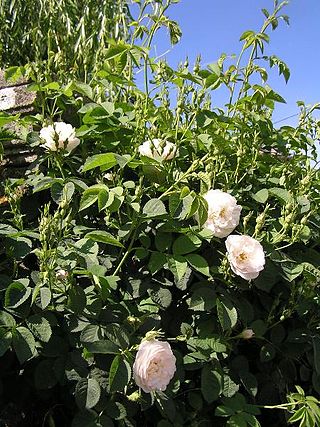
Rosa × alba, the white rose of York, is a hybrid rose of unknown parentage that has been cultivated in Europe since ancient times. It may have originally been grown mainly for the sweet scent of the flowers, but is now also used as a winter-hardy garden shrub. Cultivated forms have white or pink flowers, and most have many petals. Hybrid cultivars have also been produced with red or yellow flowers.

Rosa abyssinica is the only rose native to Africa. Europeans first learned of the rose in the writings of 19th-century Scottish botanist Robert Brown. Rosa abyssinica is included in the genus Rosa, and the family Rosaceae. No subspecies are listed in the Catalogue of Life.

Rosa setigera, commonly known as the climbing rose, prairie rose, and climbing wild rose, is a species of shrub or vine in the Rosaceae (rose) family native to central and eastern North America.

Rosa agrestis, the small-leaved sweet briar, field briar or fieldbriar, is a species of wild rose native to Europe, found mostly in southern Europe and occasionally as far as the Caucasus. Sources differ on whether it can be found in northern Africa and Anatolia.

Rosa roxburghii,, is a species of flowering plant in the family Rosaceae, native to the eastern Himalayas, Tibet, and central and southern China. In the wild it is found in thickets, mountain forests, on slopes, and alongside streams, typically 500 to 1,400 m above sea level. A diffuse shrub capable of reaching 8 m (26 ft) but usually shorter, it is available from commercial suppliers. In China, it is cultivated for its vitamin C-rich hips on 170,000 ha, mostly in Guizhou.
